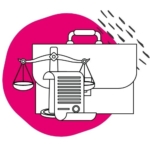What You Need to Know About the AODA
Updated: January 29, 2024
How the AODA Impacts Web and Online Video Accessibility [Free Ebook]
On January 1, 2021, Canadians and accessibility enthusiasts celebrated more than just a new year; they also marked a new phase of the AODA.
By the date above, all public websites and web content, including video content, posted after January 1, 2012, were required to meet WCAG 2.0 Level AA guidelines.
What is the AODA?
The Accessibility for Ontarians with Disabilities Act, otherwise known as the AODA, is an accessibility law based in Ontario, Canada, and it regulates standards across government, public, and private sectors. It was enacted in 2005 to create a barrier-free Ontario by 2025.
Under the AODA, all large private and non-profit organizations with 50 or more employees and all public sector organizations are required to make their websites accessible.
According to the Ontario Ministry of Community and Social Services, 1 in 7 Ontarians has a disability, which is expected to rise in the coming years.
To attain the goal of a barrier-free Ontario, the AODA has set forth a series of implementation phases to reach full compliance by 2025.
If companies aren’t proactive about accessibility, there are penalties for failing to comply with the law. Corporations can face significant fines of up to $100,000 for each day they aren’t compliant with the AODA.
Additionally, directors and officers can be found liable for fines of up to $50,000 for each day their organization fails to comply.
Learn how the AODA impacts web and video accessibility in Ontario ➡️
The AODA and WCAG 2.0
The AODA mandates that web content and online video must conform to the Web Content Accessibility Guidelines (WCAG) 2.0 AA success criteria with two exceptions: criteria 1.2.4 (live captions) and criteria 1.2.5 (audio descriptions). WCAG is the internationally accepted standard for website accessibility developed by the World Wide Web Consortium (W3C).
When organizations follow WCAG standards, they make their content accessible to users with disabilities. Considering the fact that 71% of people with disabilities leave a website immediately if it’s inaccessible, following WCAG will help attract and retain visitors to your site.
Each WCAG guideline has three levels of compliance: level A, AA, and AAA. Level AA is considered the industry standard for web accessibility and is referenced in many laws and policies worldwide, including the AODA.
Are your videos compliant with the AODA? ➡️
Producing WCAG-Compliant Videos
For video content to comply with WCAG 2.0 Level AA, it must be made accessible with captions and audio description.
For time-based media, like online video content, here’s what your organization needs to provide:
Since WCAG is backward compliant, to meet Level AA standards, you must meet Level A standards as well.
The Roadmap to Video Accessibility
The journey toward achieving accessibility may seem challenging, but with the right tools and resources, you’ll be well-equipped to give all Ontarians access to your website and video content.
This post was originally published on August 21, 2020, by Elisa Lewis and has been updated for freshness, accuracy, and comprehensiveness.
This blog post is written for educational and general information purposes only and does not constitute specific legal advice. This blog should not be used as a substitute for competent legal advice from a licensed professional attorney in your state.
Further Reading

Subscribe to the Blog Digest
Sign up to receive our blog digest and other information on this topic. You can unsubscribe anytime.
By subscribing you agree to our privacy policy.








